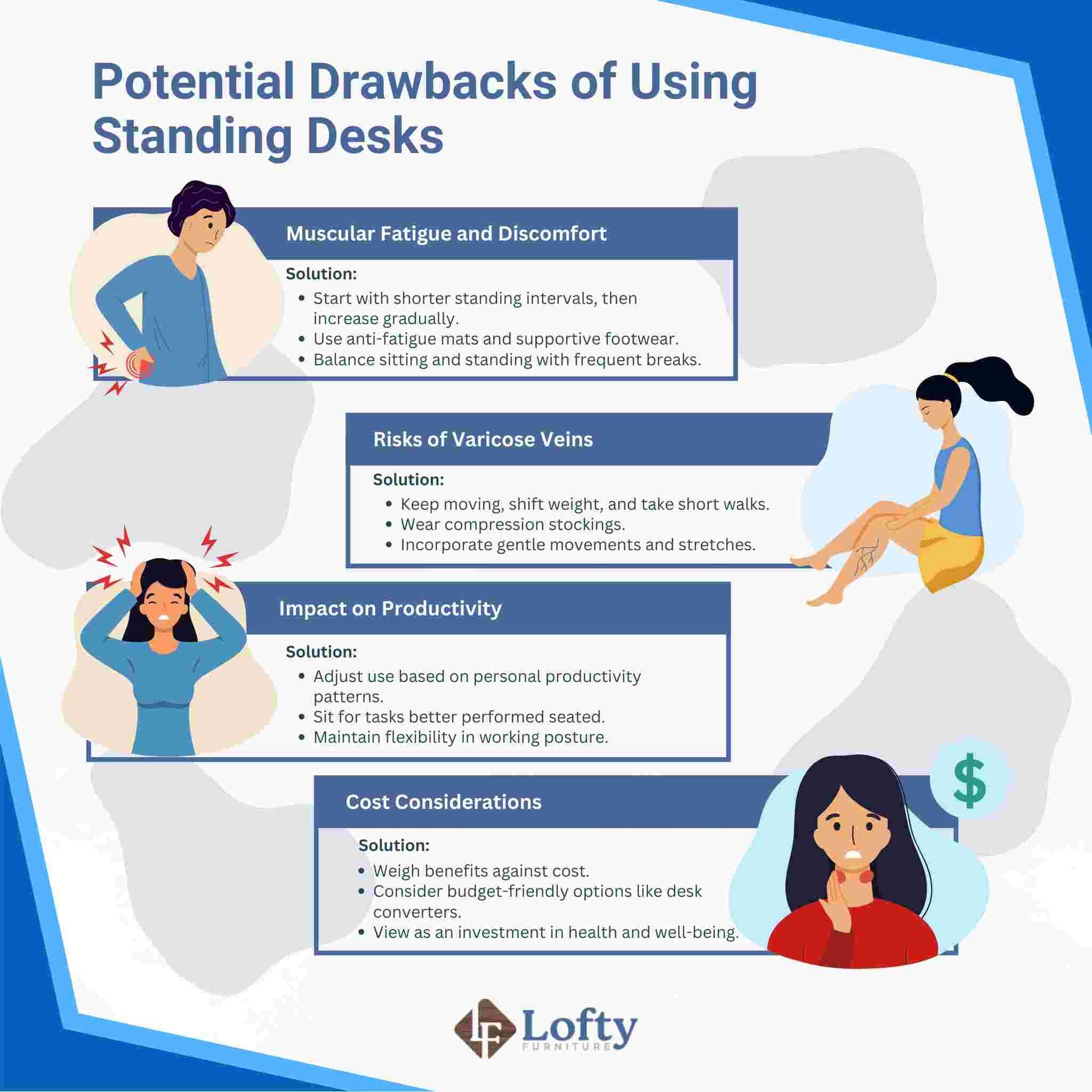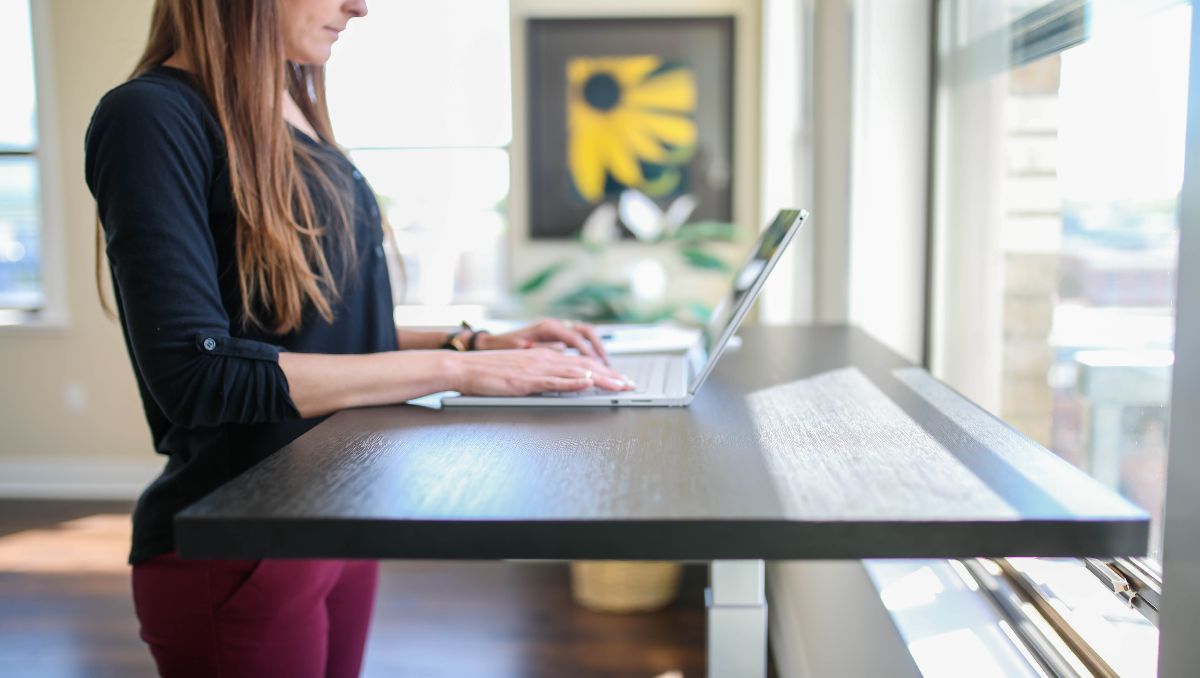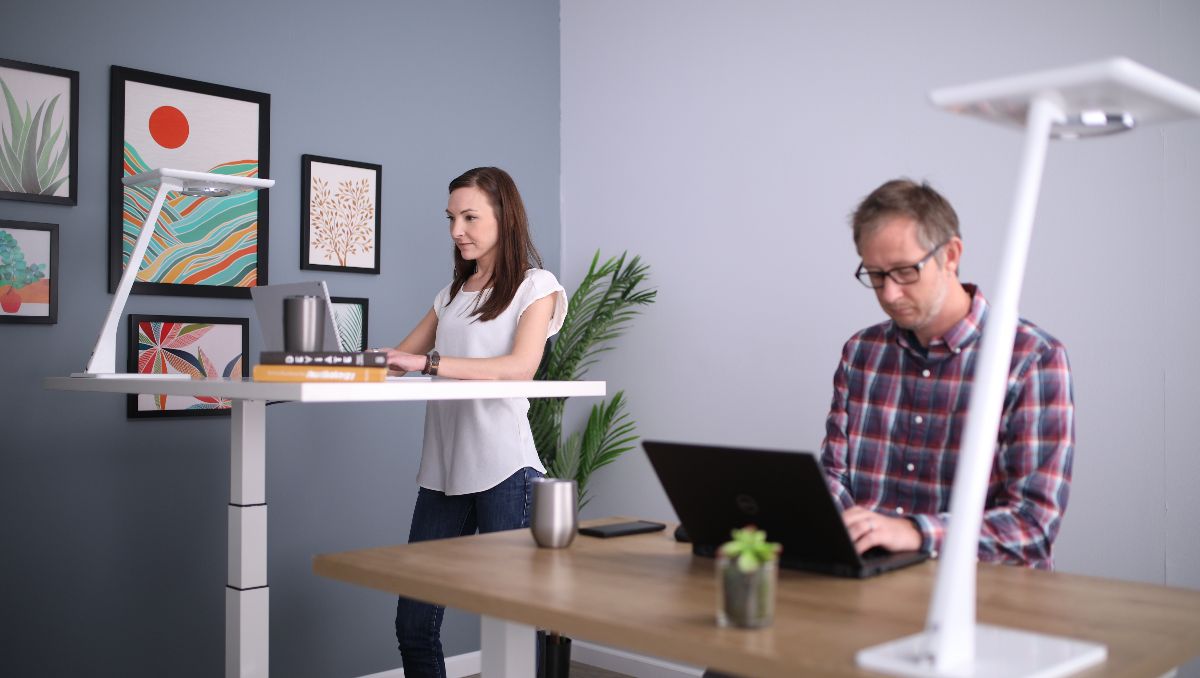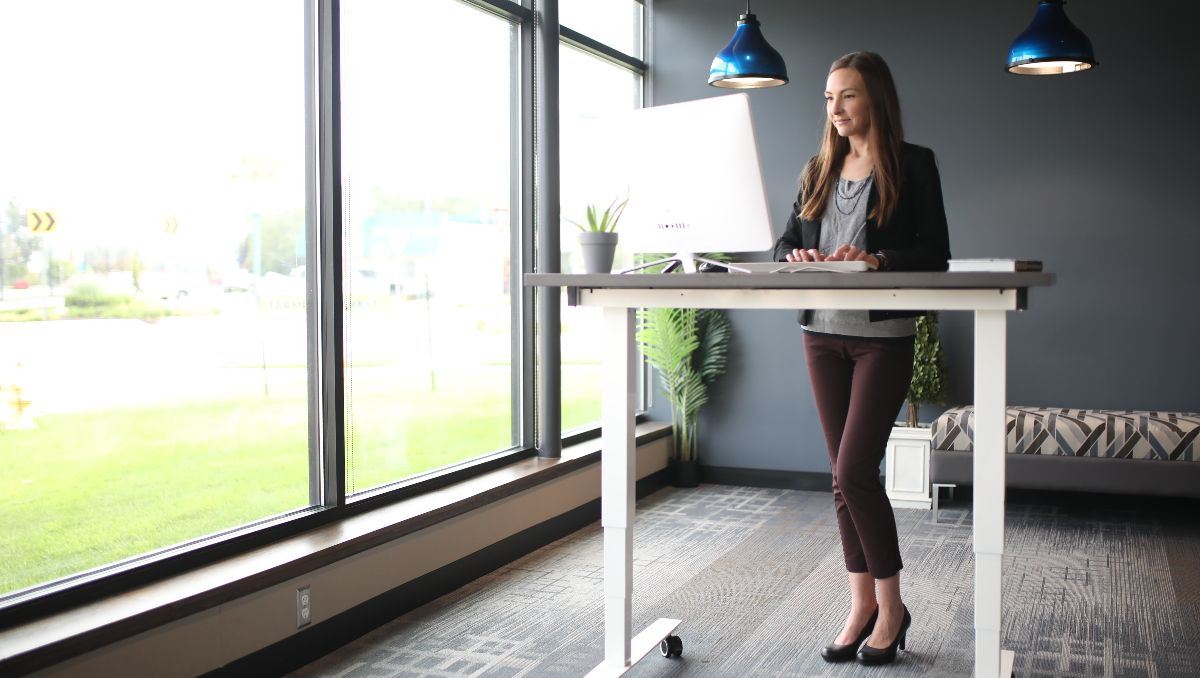In an era where your health and productivity are paramount, you might be wondering, “Are standing desks really better for you?” This question is especially pertinent for people who are keen on sustainable health solutions.
Standing desks offer varied benefits, including improved posture, increased calorie burn, and potential reduction in chronic disease risks. They represent a shift towards a healthier, more active workspace, though they aren’t a one-size-fits-all solution and require balanced use.
Curious to learn more? Let’s dive deeper into the world of standing desks. We will explore their health benefits, potential drawbacks, and how to use them effectively.
Health Benefits of Standing Desks
Transitioning to a standing desk brings several health benefits. From improving your posture to potentially enhancing your work focus, the advantages are worth considering. Let’s break down some of these benefits to see how they might apply to you.
Improved Posture and Reduced Back Pain

Adopting a standing desk can be a significant step toward improving your posture. Standing naturally encourages spinal alignment, helping you maintain a better posture compared to sitting. Additionally, this can lead to reduced back pain, a common complaint among those who spend most of their day sitting.
However, it is essential to set up your desk ergonomically to reap these benefits fully. Ensure your screen is at eye level and your arms are comfortably positioned to prevent strain on your neck and shoulders.
Incorporating a standing desk into your routine can transform your work experience. Not only does it help in alleviating existing back issues, but it also prevents potential posture-related problems. Remember, the transition to standing should be gradual to allow your body to adjust without undue stress.
Increased Calorie Expenditure
Switching to a standing desk subtly increases your calorie expenditure. While it is not a replacement for regular exercise, standing does burn more calories than sitting. This can be a part of a comprehensive approach to managing your weight and improving overall health.
However, it is important to have realistic expectations – standing desks are a complement to, not a substitute for, a healthy lifestyle.
Every bit of physical activity contributes to your wellness, and a standing desk can be a part of that equation. By simply standing, you engage more muscles than sitting, leading to slight but cumulative health benefits. This subtle shift in your daily routine can make a positive impact over time.
Reduced Risks of Chronic Diseases

Extended periods of sitting have been linked with increased risks of several chronic diseases, including heart disease and type 2 diabetes. Standing more throughout your day can help mitigate these risks. Alternating between sitting and standing can improve your blood circulation, leading to better blood sugar control, reduced blood pressure, and lower cholesterol levels.
Consider your standing desk as a tool in your arsenal for a healthier lifestyle. It’s a proactive step in reducing sedentary behavior, which is a key factor in chronic disease prevention. However, it should be part of a broader strategy that includes regular exercise and a balanced diet.
Enhanced Productivity and Focus
Many users of standing desks report a noticeable boost in productivity and focus. Standing can help reduce the feeling of lethargy and increase alertness, making it easier to concentrate on your tasks. This could be particularly beneficial during the post-lunch dip when energy levels typically plummet.
However, the impact on productivity can vary from person to person. Some tasks may be better suited to sitting, and it’s important to listen to your body’s needs. The ideal approach is to alternate between sitting and standing, allowing for a mix of postures throughout the day.
Potential Drawbacks of Using Standing Desks
While standing desks offer several benefits, it’s important to recognize their potential drawbacks. Understanding these can help you make the most of your standing desk without overdoing it. Let’s look at some of the challenges that might arise and how to address them.

Muscular Fatigue and Discomfort
Transitioning to a standing desk can initially lead to muscular fatigue and discomfort. It is vital to start with shorter standing intervals and gradually increase the duration as your body adapts.
Using anti-fatigue mats and wearing comfortable, supportive footwear can also ease the transition. The goal is to strike a balance between sitting and standing, not to completely replace one with the other.
Prolonged standing, especially without proper footwear or floor support, can strain your legs and back. It’s crucial to adjust your standing habits according to how your body feels. Frequent short breaks and alternating positions can prevent fatigue and make the use of a standing desk more sustainable in the long run.
Risks of Varicose Veins
Standing for extended periods can increase the risk of developing varicose veins, particularly if you’re predisposed to them. It’s important to keep moving, even when standing, to maintain healthy blood circulation. Regularly shifting your weight from one foot to the other, and taking short walks can help. Additionally, wearing compression stockings can provide support and reduce the risk.
The key is not to remain static. Incorporating gentle movements and stretches can alleviate the pressure on your legs. This proactive approach can help you enjoy the benefits of a standing desk while minimizing potential vascular issues.
Impact on Productivity
While standing desks can enhance productivity for some, they may have the opposite effect for others. Fine motor skills tasks or those requiring intense concentration might be better performed while sitting. It’s essential to tailor your use of the standing desk to your personal productivity patterns. Flexibility and responsiveness to your body’s cues are crucial.
Listen to your body and adjust accordingly. If a task feels more comfortable or is performed more efficiently while seated, don’t hesitate to sit down. The objective is to find a healthy balance that supports both your physical well-being and work efficiency.
Cost Considerations
One cannot overlook the cost aspect of standing desks. High-quality, adjustable type of standing desk can be quite an investment. Balance the benefits against the cost and consider if the investment aligns with your health priorities and budget. There are more budget-friendly options, like desk converters, which can offer some of the benefits of a standing desk without the full cost.
When weighing the cost, consider the long-term health benefits and potential productivity boosts. A standing desk is not just a piece of furniture; it’s an investment in your health and well-being. However, it’s important to choose a solution that fits your financial situation and lifestyle.
Common Misconceptions and Myths
When it comes to standing desks, there’s a fair share of misconceptions floating around. It’s crucial to separate fact from fiction, especially for people who value practical and efficient solutions in their lifestyle. Let’s address some common myths to ensure you’re well-informed about what standing desks can and cannot do for you.

#1 Standing all day is better than sitting all day
The idea that standing all day is inherently better than sitting all day is a common misconception. Just like prolonged sitting, standing for too long can also have adverse effects on your health, including increased risk of leg pain and varicose veins. The key is not to replace sitting entirely with standing, but to find a healthy balance between the two.
Your body thrives on movement and variation. Alternating between sitting and standing throughout the day is the best approach. This not only helps in reducing the strain on your body but also keeps you energized and productive.
#2 Standing desks are a one-size-fits-all solution
Standing desks are often considered as the main remedy for various health and productivity issues, but this isn’t the case. They are a tool, and like any tool, its effectiveness depends on how they are used. A standing desk might be beneficial for one person but less so for another, depending on individual health conditions, work habits, and personal preferences.
Remember, what works for someone else may not work for you. It’s important to assess your specific needs and work style before deciding to switch to a standing desk. This individualized approach ensures that you reap the maximum benefits from your standing desk.
#3 Standing desks guarantee weight loss
Another common myth is that standing desks are a surefire way to lose weight. While standing does burn slightly more calories than sitting, it’s not enough to lead to significant weight loss on its own. A standing desk should be part of a broader lifestyle change that includes a balanced diet and regular exercise for effective weight management.
Relying solely on a standing desk for weight loss can lead to disappointment. It’s better to view it as a supplement to a healthy lifestyle, not a replacement for more established weight loss methods.
Tips for Using Standing Desks Effectively
Now that we’ve busted some myths, let’s focus on how to use standing desks effectively. Whether you’re a seasoned user of ergonomic work tools or just beginning to explore the world of standing desks, these tips will help you get the most out of your experience. Here’s how to integrate a standing desk into your daily routine for maximum benefit.
Finding the Right Balance Between Sitting and Standing

The most important aspect of using a standing desk is finding the right balance between sitting and standing. Start by standing for short periods, gradually increasing the duration as your body becomes accustomed. Aim for a mix of sitting and standing throughout your day to avoid the pitfalls of either extreme.
Listen to your body’s signals. If you start feeling tired or uncomfortable while standing, it’s time to sit down. This balance ensures you enjoy the benefits of both postures without overexerting yourself.
Proper Ergonomics and Desk Setup
To make the most of your standing desk, proper ergonomics is key. Ensure that your desk is at elbow height, allowing your arms to rest comfortably while typing. Your screen should be at eye level to avoid straining your neck, and your feet should be flat on the ground or a footrest.
An ergonomic setup reduces the risk of musculoskeletal discomfort and improves overall comfort while working. Investing in a standing desk or an ergonomic chair can make a significant difference in your workspace’s comfort and efficiency.
Incorporating Movement and Stretching Breaks
Incorporating regular movement and stretching breaks is vital. Standing still for long periods can be just as harmful as prolonged sitting. Take short breaks to walk, stretch, or do some light exercises to keep your body active and prevent stiffness.
These breaks not only improve circulation but also boost your energy and productivity. Setting regular reminders to move or stretch can be helpful in maintaining this routine.
Gradual Transition to Standing
If you’re new to standing desks, it’s important to transition gradually. Start by standing for 20-30 minutes at a time, then slowly increase as you feel comfortable. This gradual approach helps your body adapt without causing undue strain or fatigue.
Rushing into standing all day can lead to discomfort and a negative experience. A slow and steady approach will ensure a smoother transition and a more sustainable use of your standing desk.
Listening to Your Body and Adjusting As Needed
Finally, the most important tip is to listen to your body. If you feel any discomfort or fatigue, adjust your sitting and standing durations accordingly. Paying attention to your body’s needs and responding appropriately is crucial for a positive and beneficial experience with your standing desk.
Remember, the goal is to enhance your health and productivity, not to endure discomfort. By being attuned to your body’s needs, you can tailor the standing desk experience to best suit your individual requirements.
Additionally, health practitioners are confronting problematic postural issues every day in patients who have a lifestyle that is prone to long periods of sitting. This is what happens when we slip into a day full of prolonged sitting, day by day.
According to Dr. John Tickell, for many of us, a typical day is equivalent to a “12-hour long haul flight” every day! When sitting 90% of the time, you get this thing called blood pooling and so everything slows down. The blood starts to clog up and it forms an embolism.”
That is why incorporating standing desks into your workspace is helpful to counteract the detrimental effects of prolonged sitting.
Final Thoughts
In conclusion, standing desks can offer a range of benefits, from improved posture to potentially reduced risks of chronic diseases. However, it’s important to approach them with a balanced perspective, understanding that they are not a cure-all solution. By debunking common myths and applying practical tips, you can make the most out of your standing desk.
Remember to listen to your body, find the right balance between sitting and standing, and adjust your routine as needed. With these strategies in place, you can enjoy the benefits of a standing desk while minimizing any potential drawbacks.


